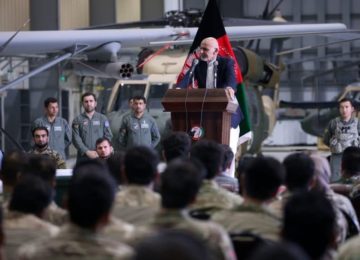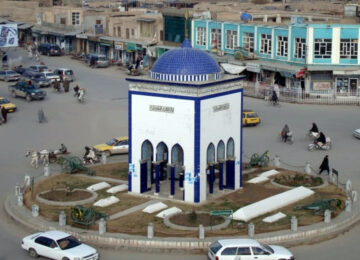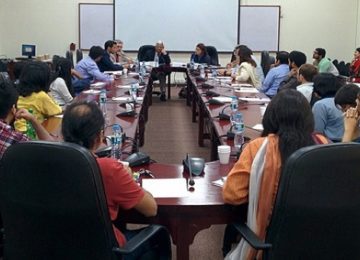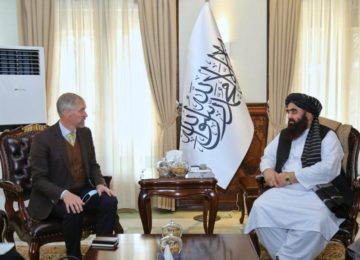Afghan authorities have solved one of the most long-standing and consequential problems in the country‘s complex election system: the number of districts. It is 387. This is pending a final decision by parliament, as there are some so-called ‘temporary’ districts that could boost the number. If parliament takes this issue up, however, there is a chance that it throws this hard-won unanimity over board again. This is because the number of districts is not just an administrative matter but also one of resources and influence. AAN’s Thomas Ruttig (with input from Ali Yawar Adili) have looked at the figures, what they mean and what questions are still open.
Afghanistan’s more than bumpy road to the next elections has led to at least one positive outcome. Almost unnoticed,the country’s Central Statistics Office (CSO) and the Independent Directorate of Local Governance (IDLG) have, for now, come up with a joint, consolidated list of how many districts Afghanistan has. It has handed this list over to the Independent Election Commission (IEC) that has used it in preparing the elections. The number is: 387 (see the list here, in Dari).
Now the three major election-related Afghan institutions are using the same numbers. With this, a major technical hurdle has been cleared on the way to holding the country’s first district elections.
Previously, both IDLG and CSO had divergent and inconsistent lists. For instance, in May this year, AAN was given an IDLG print-out titled “The structure of administrative units of the provinces and districts of Afghanistan 1396 [2017-18]” that said Afghanistan had 382 districts. The same number appeared in the CSO’s annual “Estimated Population” review for 2017-18 – but only the total was similar in both lists. They deviated on which districts existed in several provinces. (1) Some international actors in Afghanistan are still using sometimes significantly different figures (more about this below). Even so, it is really good news that the CSO and IDLG have come up with a joint result.
The bad news is, as reported by AAN, that the IEC, facing a severe shortage of candidates for the 20 October 2018 district council elections, felt compelled to suggest a delay until April next year, when the presidential and provincial council polls are being held. That sounds like a tall order. It is possible that the delay could re-open the discussions about district numbers – as will be explained below.
What does the CSO/IDLG list look like?
The new, consolidated district list does still have one small flaw and some major gaps. The flaw is that its serial numbers run up to 389, not to 387. One district – Ghormach – turns up twice. It is listed under both Badghis and Faryab provinces, with the remark – in red – that it had been “temporarily transferred” to Faryab. This means that the authors forgot to give it only one serial number (this looks like an Excel sheet problem). However, even when this is corrected, the list still contains 388, not 387 districts.
The remaining discrepancy can be solved by looking at four large gaps in the list where the districts for four provinces, Daykundi, Nangrahar, Paktia and Uruzgan, are completely missing. The reason, as the IEC’s head of field operations Zmarai Qalamyar told AAN in a phone conversation in late July 2018, is that the CSO had yet to provide the population figures of some newly-established districts in those provinces. (2) (The authors could have put in the district names anyway, as they seem to be uncontroversial, and just left the population figures open, but chose not to.) How many districts there are in these four provinces can be gauged from the missing serial numbers in the alphabetical order of the provinces: namely, Uruzgan has six, Paktia 14, Daykundi nine and Nangrahar 24 districts. The same numbers also turn up in a – complete – list of all districts given on the CSO website in its latest “Estimated Populatiuon [sic] of Afghanistan 2018-19.”
This CSO list also solves the riddle of the superfluous 288th district: it is Nawmesh (sometimes called Nawamesh) which, similar to Ghormach, is listed under two provinces and counted twice (more background in this AAN dispatch). This district– a Hazara majority area – was split from the Pashtun-majority Baghran district in northern Helmand by a presidential order in March 2016 and the IDLG temporarily transferred the administration of its security, administrative and logistical affairs to Daykundi in June 2017. But the IEC announced that the elections would still be managed from Helmand, which has led to protests among the local population who prefer to be handled by Daykundi – see this photo in an Afghan media report, saying, “We Don’t Accept this Decision”.) (3)
Nawmesh is also a so-called ‘temporary’ (mu’aqati) district – in contrast to ‘official’ districts that are uncontroversial (but not yet officially delineated and recognised by parliament). The IDLG defines a ‘temporary district’ (in an 11 June 2017 official letter to the IEC of which AAN obtained a copy) as those districts that have been approved after entry into force of the 2004 constitution by the president due to security or other considerations, but have not yet been approved by parliament. MPs have the final say on this, according to the constitution.
Other district lists
The most recent quarterly report from the United States government’s Special Inspector General for Afghanistan Reconstruction (SIGAR) (here, on p131) published in July 2018, cites two sets of district numbers when it analyses district control: “There are 407 districts in Resolute Support’s dataset and 399 districts in USAID’s third-party monitor’s dataset.” Both differ from the CSO/IDLG list. It is surprising that even the different institutions of Afghanistan’s largest donor have not reconciled their own data. Resolute Support’s list of 407 districts includes the 34 provincial centres, but taking them out would leave only 373 districts, still different from the USAID and CSO/IDLG lists. (It can be seen in Appendix F of the report, pp 239-49.).
The United Nation’s humanitarian coordination agency, UNOCHA, uses a list – like USAID – of 399 districts when compiling the data on conflict-induced internal displacement. The European Asylum Support Office (EASO), an European Union institution that, among other tasks, provides security-related data about the countries of origin of asylum seekers, including Afghanistan, cites 368 districts in its most recent country report from December 2017. The most recent UN Office of Drugs and Crime’s opium survey (for 2017) has a list of 413 administrative units which also includes the 34 provincial centres, so that this results in a list of 379 districts.
Districts as perks and the for-ever delay of district council elections
One of the reasons why district council elections have never been held, despite being mandated by the 2004 constitution is that the number of districts is highly controversial. In particular, the delineation of their borders is disputed, ie which areas, villages etc belong to which district and where their inhabitants should vote. This means that an authorised list has never been finally approved by parliament. (4) Despite the consolidated CSO/IDLG list, this still remains to be resolved.
When this author, as a United Nations member of staff, was involved in helping to organise the Emergency Loya Jirga (ELJ) in 2002, the delegates for which were determined through a district-based selection-and-election process (5), the figure of how many districts existed in the country was already a problem. There was no generally accepted list of districts, but after long discussions, the Afghan interim authorities, the Independent ELJ Commission and the UN in an advisory (but driving) role settled on 339 districts. (6) That is almost forty districts or 12 per cent fewer than are counted now.
The additional problem is that there are not only ‘temporary’ districts created after 2004, ie under presidents Hamed Karzai and Ashraf Ghani, but others which are sometimes called “unofficial.” These were created before 2004, by previous governments, often by splitting older, existing districts. This was done under the various regimes of the People’s Democratic Party of Afghanistan (PDPA) (AAN background here), as well a the mujahedin and Taleban regime. Since 2001, under Presidents Hamed Karzai and Ashraf Ghani, new ‘unofficial’ districts have been created in the same way. (New provinces have also been created using this model.) (7)
Sometimes, these rearrangements answered to local demands by certain population groups who felt underrepresented in the larger ‘old’ district or simply in order to create paid administrative jobs for the clientele of a particular powerful politician. Badakhshan, with its record number of 27 districts, might be a point in case (former president Borhanuddin Rabbani was from there), Panjshir with its very small population but now nine districts, or Kandahar, where the Karzai family’s home area, Dand, was made a district.
It looks, as if the list of existing districts has been uncontroversial up to the breakdown of state institutions in the violent transition from the PDPA to the mujahedin government in the early 1980s and then further on to the Taleban regime and after its fall. (8) Now, no one dares ‘dismantle’ districts from those periods, in order to not confront those who created them, as some of those politicians or their followers are still powerful in parliament and elsewhere.
Conclusion: A step forward, but not yet the final one
While administratively, the country’s institutions have solved – at least for the time being – the long-standing issue of the number of officially recognised districts, parliament has still to approve it. It also has to tackle the still pending issue of district delineation. Both are more than just administrative problems, as the creation of districts and the allocation of resources to them (their tashkil of staff and budget) has been used by consecutive governments to the benefit of themselves and their allies. The mash of official, unofficial and temporary districts and the vested interests behind their creation has made the issue extremely difficult to resolve.
In combination with Afghanistan’s still absent population data (there has still been no census), this issue has stood and stands in the way of the legitimacy of any election in Afghanistan. Holding a census is also hampered by severe disputes about whether it should also be used to determine the numbers of the diverse ethnic groups in the country. Holding a census, therefore, throws up similar – actually more serious and dangerous – controversies as the distribution of new ID cards has done (AAN analysis here and here).
But so far, the failure to organise district council elections has allowed everyone to ignore this problem. With the district council elections that are (or were – the decision on whether to delay them is pending) scheduled for 20 October 2018, this was no longer feasible. Without an exact number of districts, it would be simply impossible to hold district elections.
The possibility of a delay of the district elections has mixed blessings. As the IEC and IDLG have argued, the time won by a delay might help them sort out other related issues, such as what exactly the district councils will be responsible for, what their budgets will be and what and whether councillors will be paid. At the same time, parliament – with its opposing interest groups – might take up the issue and open the district list up again.
Edited by Kate Clark
(1) In December 2017, AAN received a list from the (now former) IDLG spokeswoman Munera Yusufzada which had 385 districts. These figures were also used as the basis for the polling centre assessment in August and September 2017 (see its AAN analysis here), as Shahla Haque, the (then) acting head of the IEC secretariat, confirmed to AAN on 27 December 2017. Since then, however, two more districts have been created so that Yusufzada’s list was probably already correct and coordinated between CSO, IDLG and the commission.
(2) Afghanistan’s population statistics is another issue. There has never been a full census. The following information is based on data the author received when working for the UN in 2002 and a 2014 article by Najib Manalai published at the Afghan economy-focussed news website Wadsam:
The CSO was founded in 1972 with USAID funding in order to prepare and conduct a comprehensive survey of Afghanistan’s population. The survey was preceded by the collection and aggregation of compiled data from the ministries of interior (conscription and National ID cards distribution) and of agriculture and irrigation (quantity of fertilizer distributed). The results of this survey were published in 1973 as the “Provincial Gazetteer of Afghanistan” (PGA). It counted a total population of about 14 million, which included a presumed number of two million Kuchis. A census had been planned for the summer of 1978, at a time when large parts of the country were already in a state of war. CSO staff claimed that the ‘objectives’ of the census were reached to only about 70 per cent. The results were partially published in 1983 as the “Locality Gazetteer of Afghanistan.” It counted 16 million Afghans. All CSO records published since (under the communists, the mujahedin’s Islamic State of Afghanistan and the Taleban Emirate are based on the 1978 figures with subsequent extrapolations on the basis of an assumed growth rate – initially 1.9 per cent and,since 2007, 2.05 per cent.
In 2004, the United Nations Population Fund conducted a countrywide household survey which is now used as the CSO’s basis to project the total in-country population. For 2017-18, the CSO gave a figure of 29.7 million.
Manalai also quotes other sources and figures, such as figures based on household data collected during the National Immunization Days (estimate of 44.8 million for 2014) and estimates provided by the Ministry of Rural Rehabilitation and Development based on the National Solidarity Program (36.3 million in 2014).
(3) The not yet final joint CSO/IDLG list contains the following 16 temporary districts:
Bamian (1): Yakaolang II (Yakaolang having been split into two)
Panjshir (1): Abshar
Kunduz (3): Kalbad, Aqtash, Gortepe (in the list, it is mistakenly called “Gultepe” – perhaps someone deliberated changed the nasty-sounding ‘Tomb Hill’ into ‘Flower Hill’). These districts are all under Taleban control (read more here)
Kandahar (2): Dand (the Karzai’s family’s home place), Takhtapul
Kunar (1): Sheltan (this district is older than 2004; it already appeared on the 2002 district list used by the Emergency Loya Jirga)
Laghman (1): Badpash (background in this AAN dispatch)
Nimruz (1): Delaram
Herat (4): Zerkoh, Zawol, Poshtkoh, Koh-e Zawar (the list contains a fifth district marked as ‘temporary’, Shindand – but that is actually the remainder of the older, larger district from which the four others were divided from)
Helmand (2): Marja (more here), Nawamesh.
The IDLG, however, says there are altogether 23 temporary districts, so seven must be missing from the latest but incomplete CSO/IDLG list.
Four others are, however, included in the IDLG letter sent to the IEC in June 2017:
Uruzgan (1): Chinarto
Paktia (2): Laja Mangal, Mirzaka
Daykundi (1): Pato
This means that since June 2017, three more temporary districts seem to have been created. Where they are, we will only learn when the CSO and IDLG publish their complete list.
(4) The size (number of seats) of the planned district councils is also determined on the basis of the size of the district’s population, as article 60 of the relevant law stipulates:
Each district shall have a council, members of which shall be elected by the voters of the same district for a term of three years. Allocation of Seats to District Council
Article 61:(1) The seats of the district council are allocated in proportion to the population of each district as below: 1 A district with a population of up to forty thousand, 5 seats. 2 A district with a population of more than forty thousand up to seventy thousand, 7 seats. 3 A district with a population of more than seventy thousand up to one hundred thousand, 9 seats. 4 A district with a population of more than one- hundred thousand, 11 seats. (2) A minimum of 25% of the seats of each District Council shall be allocated to female candidates. (3) A nomad may participate in district council elections of any district as a voter and or a candidate.
There are 175 districts with five seats. They are: 1) Badghis: Muqur; 2) Bamyan: Kahmard, 3) Shibar, 4) Saighan, 5) Yakawlang Two; 6) Badakhshan: Jurm 7) Shuhada, 8) Yawan, 9) Taskhan, 10) Baharak, 11) Tagab, 12) Shighnan, 13) Darwaz-e Payin (Mami), 14) Shaki, 15) Yamgan/Girwan, 16) Darwaz-e Bala/Nisi, 17) Kuf Ab, 18) Warduj, 19) Kohistan, 20) Khwahan, 21) Arghanjkhwah, 22) Wakhan, 23) Eshkashem, 24) Karan wa Manjan, 25) Zibak; 26) Baghlan: Deh Salah, 27) Khenjan, 28) Tala wa Barfak, 29) Pul-e Hesar, 30) Andarab, 31) Khwaja Hejran/Jelga, 32) Farang wa Gharu, 33) Guzargah-e Nur; 34) Balkh: Kaldar, 35) Marmal; 36) Parwan: Koh-e Safi, 37) Salang, 38) Shiekh Ali; 39) Paktika: Barmal, 40) Geyan, 41) Zarghun Shahr, 42) Dila wa Khushamand, 43) Mata Khan, 44) Janikhel, 45) Sar Rawza, 46) Wazakhwah, 47) Yahyakhel, 48) Yusufkhel, 49) Sarobi, 50) Nika, 51) Omna, 52) Gomal, 53) Wurmamai, 54) Tarwa; 55) Panjshir: Rokha, 56) Anaba, 57) Paryan, 58) Dara, 59) Shotul, 60) Abshar; 61) Takhar: Kalafgan, 62) Bangi, 63) Dasht-e Qala, 64) Baharak, 65) Chal, 66) Darqad, 67) Khwaja Bahauddin; 68) Hazar Sumuj, 69) Namak Ab; 70) Jawzjan: Khwaja Du Koh, 71) Qarqin, 72) Qushtepa, 73) Khaneqa, 74) Khamyab; 75) Khost: Nader Shah Kot, 76) Gurbuz, 77) Spera, 78) Haji Maidan, 79) Bak, 80) Shemal, 81) Qalandar; 82) Zabul: Arghandab, 83) Shamulzai, 84) Kakar/Khak-e Afghan, 85) Shinkai, 86) Nawbahar, 87) Tarnak aw Jaldak, 88) Mizan, 89) Atghar; 90) Samangan: Feruz Nakhchir; 91) Ghazni: Giro, 92) Jaghatu, 93) Nawa, 94) Ajrestan, 95) Ab Band, 96) Wali Muhammad Shahid/Khugyani, 97) Khwaja Omari, 98) Rashidan, 99) Zana Khan; 100) Ghor: Dolina, 101) Saghar, 102) Dawlatyar, 103) Charsada; 104): Faryab: Khan Chahar Bagh, 105) Qaramqul; 106) Farah: Bakwa, 107) Qala-ye Kah, 108) Khak-e Safid, 109) Lash wa Juwayn, 110) Anar Dara, 111) Shib Koh; 112) Kabul: Chahar Asiab, 113) Istalif, 114) Kalakan, 115) Musahi, 116) Guldara, 117) Farza, 118) Khak-e Jabbar; 119) Kapisa: Alasay, 120) Kohband; 121) Kunduz: Kalbad, 122) Aqtash, 123) Gultepa (Gurtepe); 124) Kandahar: Daman, 125) Arghestan, 126) Maruf, 127) Khakrez, 128) Mianeshin, 129) Nesh, 130) Shurabak, 131) Ghorak, 132) Reg/Shaga, 133) Takhtapul (temporary); 134) Kunar: Sawki, 135) Khas Kunar, 136) Nurgal, 137) Chapadara, 138) Narang wa Badil, 139) Narai, 140) Watapur, 141) Sirkanay, 142) Bar Kunar, 143) Marawara, 144) Ghaziabad, 145) Dangam, 146) Shaigal, 147) Shiltan; 148) Laghman: Dawlat Shah, 149) Badpakh; 150) Logar: Kharwar, 151) Khoshi, 152) Azra; 153) Maidan Wardak: Behsud One, 154) Dai Mirdad; 155) Nuristan: Nurgram, 156) Kamdesh, 157) Manduwal, 158) Waigal, 159) Barg-e Matal, 160) Wama, 161) Du Ab; 162) Nimruz: Chahr Burjak, 163) Khashrud, 164) Asl-e Chakhansur, 165) Kang, 166) Delaram; 167): Herat: Farsi, 168) Chesht-e Sharif, 169) Pusht-e Koh, 170) Koh-e Zur; 171) Helmand: Rig (Khaneshin), 172) Dishu, 173) Washir, 174) Marja, 175) Nawa Mesh.
There are 85 districts with seven seats. They are: 1) Bamyan: Yakaolang One; 2) Badakhshan: Darayem, 3) Yaftal Sufla, 4) Shahr-e Bozorg, 5) Raghistan, 6) Khash; 7) Baghlan: Khost wa Farang, 8) Dahana-ye Ghori, 9) Baraka; 10) Balkh: Kushenda, 11) Nahr-e Shahi, 12) Chaharkent, 13) Zari, 14) Shurtepa; 15) Parwan: Jabal ul-Seraj, 16) Sayyedkhel, 17) Shinwari, 18) Surkh Parsa; 19) Paktika: Urgun; 20) Panjshir: Hesa-ye Awal/Khenj; 21) Takhar: Eshkamesh, 22) Farkhar, 23) Yangi Qala, 24) Warsaj; 25) Jawzjan: Darzab, 26) Mengjak, 27) Faizabad, 28) Mardyan; 29) Khost: Tanai, 30) Manduzai/Ismailkhel, 31) Terezai/Alisher, 32) Musakhel; 33) Zabul: Shajoy, 34) Dai Chopan; 35) Sar-e Pul: Gusfandi, 36) Sayyad, 37) Balkhab, 38) Suzma Qala; 39) Samangan: Dara-ye Suf Bala, 40) Ruy-e Du Ab, 41) Hazrat Sultan, 42) Khuram wa Sarbagh; 43) Ghazni: Gilan, 44) Muqur, 45) Deh Yak, 46) Waghaz; 47) Ghor: Shahrak, 48) Tolak; 49) Faryab: Kohestan, 50) Belcharagh, 51) Khwaja Sabs Posh Wali, 52) Dawlatabad, 53) Qurghan, 54) Andkhoy, 55) Ghormach; 56) Farah: Purchaman, 57) Gulestan, 58) Pusht-e Rud; 59) Kabul: Bagrami, 60) Sarobi, 61) Deh Sabz, 62) Mir Bacha Kot; 63) Kapisa: Kohestan Two; 64) Kunduz: Aliabad; 65) Kandahar: Arghandab, 66) Maiwand, 67) Shah Wali Kot, 68) Dand; 69) Kunar: Dara-ye Pech; 70) Logar: Charkh; 71) Maidan Wardak: Narkh, 72) Jalrez, 73) Jaghatu; 74): Herat: Karkh, 75) Zendajan, 76) Kohsan, 77) Adraskan, 78) Kushk-e Kohna, 79) Zer Koh, 80) Zawal, 81) Shindand; 82) Helmand: Baghran, 83) Sangin, 84) Musa Qala, 85) Nawzad.
There are 45 districts with nine seats. They are: 1) Badghis: Qades, 2) Jund, 3) Ab Kamari; 4) Bamyan: Panjab; 5) Badakhshan: Kashm, 6) Argo; 7) Baghlan: Nahrin, 8) Dushi; 9) Balkh: Chemtal, 10) Chahr Bolak, 11) Khulm, 12) Dehdadi; 13) Takhar: Chah Ab, 14) Khwaja Ghar; 15) Jawzjan: Aqcha;16) Khost: Sabari (Yaqubi); 17) Sar-e Pul: Kohestanat; 18) Samangan: Dara-ye Suf Payin; 19) Nawur, 20 Malestan; 21) Ghor: Taiwara; 22) Faryab: Shirin Tagab, 23) Gurziwan, 24) Almar; 25) Farah: Bala Bulok; 26) Kabul: Shakardara, 27) Qarabagh; 28) Kapisa: Tagab, 29) Kohistan One; 30) Kunduz: Dasht-e Archi, 31) Chahardara, 32) Qala-ye Zal; 33) Kandahar: Panjwayi, 34) Zherai; 35) Laghman: Alishing; 36) Logar: Baraki Barak, 37) Muhammad Agha; 38) Maidan Wardak: Chak-e Wardak; 39) Herat: Gulran, 40 Ghorian, 41) Oba; 42) Helmand: Nawa-ye Barakzai, 43) Nad Ali, 44) Garmsir, 45) Kajaki.
And there are 31 districts with 11 seats which are: 1) Badghis: Bala Murghab; 2) Bamyan: Waras; 3) Baghlan: Baghlan-e Jadid; 4) Balkh: Balkh, 5) Sholgara, 6) Dawlatabad; 7) Parwan: Bagram, 8) Siahgerd/Ghorband; 9) Takhar: Rustaq; 10) Sar-e Pul: Sancharak; 11) Ghazni: Jaghori, 12) Qarabagh, 13) Andar; 14) Ghor: Lal wa Sar Jangal, 15) Pasaband; 16) Faryab: Pashtun Kot, 17) Qaisar; 18) Kabul: Paghman; 19) Kapisa: Nejrab; 20) Kunduz: Hazrat Imam Saheb, 21) Khanabad; 22) Kandahar: Spin Boldak; 23) Laghman: Qarghayi, 24) Alingar; 25) Maidan Wardak: Markaz-e Behsud, 26) Sayyedabad; Herat: 27) Enjil, 28) Guzara (Nezam Shahid), 29) Keshk/Rubat Sangi, 30) Pashtun Zarghun; 32) Helmand: Nahr-e Seraj.
(5) The more than 1000 delegates for the ELJ were chosen in a combined selection/election (entesab/entekhab) process. There were district assembles held in which all ethnic, political and social groups were supposed to be represented and which agreed, by acclamation, who the district’s representatives would be. These were then sent to the provincial centre to decide, in a secret ballot, who the province’s delegates would be. The numbers of representatives and delegates were based on a population-related quota system.
(6) The district list of the ELJ is in the author’s archive. Under today’s circumstances, it would contain only 337 districts, as Panjshir and Daykundi were not yet provinces, and their later provincial capitals would be classed as districts. (Provincial capitals will not have district elections, but, also at some point in the future and again, according to the constitution, municipal elections.)
(7) For example, the following provinces were created:
Paktika latest by 1970s (no exact year available) from eastern parts of Ghazni (called Katawaz) and the southern parts of Paktia
Sarepul, the former southern half of Jawzjan, by the PDPA in 1988
Khost from the eastern of Paktia between 1988 and 1992
Nuristan from the northern halves of Laghman and Kunar, apparently under the mujehedin government of the Islamic State of Afghanistan in the 1990s
Panjshir from the northeastern part of Parwan in 2004 (around 1973, it temporarily belonged to Kapisa)
Daykundi (the northern, Hazara-populated half of Uruzgan) also in 2004.
Particularly unsafe districts have also been shifted, similar to Ghormach, for example Shindand and Farsi from Farah to Herat, Darzab (then still including Qushtepe – the area in which, until recently self-proclaimed Islamic State groups operated, see AAN reporting here) from Faryab to Jawzjan and Kaldar and Kholm from Samangan to Balkh (under the PDPA) and Azra from Paktia to Logar (under Karzai).
There are also longstanding demands to create a ‘Turkmen’ province in northern Jawzjan or another ‘Hazara’ province from Ghazni’s western districts. This is reflected in the current discussions about splitting the provincial constituency of Ghazni for the Wolesi Jirga election into three, to ensure better, ethnically-balanced representation (AAN analysis here).
(8) A reader, Roger Helms, has kindly directed us to a collection of maps that he has compiled and put on the ArcGIS On Line platform and show Afghanistan’s provinces and districts over time (see here) which, among others, includes a 1973 map with then 29 provinces and 325 and one from 1998 with 32 provincesand 329 districts. Separately, he has worked existing CSO district data into a list that shows the current situation (here). It corresponds both with the CSO/IDLJ list and confirms our findings where the list had the gaps described above.
In between the 1973 and the 1998 maps falls an undated district list from the mid-1980s – ie before the creation of Khost and Sarepul by the PDPA regime in 1988 – that is in this author’s archive. It also shows 29 provinces, but a significantly lower number of 230 districts (not counting the provincial capitals). The difference between this list and the two mentioned maps is that it only contains districts (wuluswalis), not also the subdistricts (elaqadaris) which then, however, also still existed. Elaqadaris were dropped as a level of administrative units after 2001; they were either upgraded to districts or merged with or into other administrative units.
By Special Arrangement with AAN. Original link.
Disclaimer: Views expressed on this blog are not necessarily endorsed or supported by the Center for Research and Security Studies, Islamabad.








